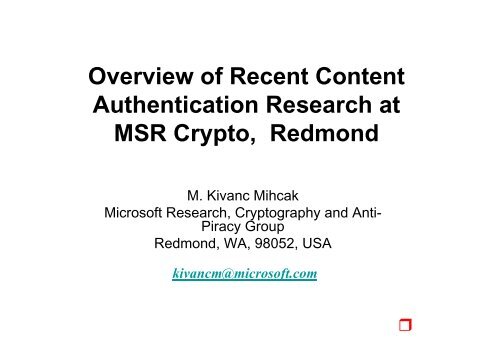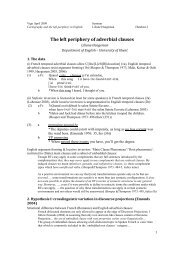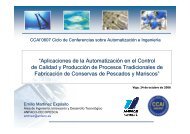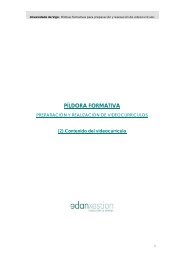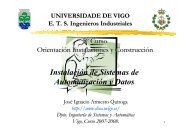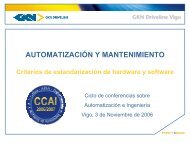M. Kivanc Mihcak - UVigo-Tv
M. Kivanc Mihcak - UVigo-Tv
M. Kivanc Mihcak - UVigo-Tv
Create successful ePaper yourself
Turn your PDF publications into a flip-book with our unique Google optimized e-Paper software.
Overview of Recent Content<br />
Authentication Research at<br />
MSR Crypto, Redmond<br />
M. <strong>Kivanc</strong> <strong>Mihcak</strong><br />
Microsoft Research, Cryptography and Anti-<br />
Piracy Group<br />
Redmond, WA, 98052, USA<br />
kivancm@microsoft.com
OUTLINE<br />
• Tamper-resistant biometric IDs: Using encrypted<br />
face and iris information to prevent forged<br />
identities<br />
• Counterfeit resistant optical fibers: Using<br />
randomly-scattered optical fibers to detect<br />
forged products<br />
• Image watermarking against content forgery:<br />
Using fragile and robust invisible watermarks to<br />
yield tamper-evident and traceability information
Part I: Tamper-Resistant<br />
Biometric IDs<br />
Main Contact: Darko Kirovski<br />
E-mail: darkok@microsoft.com
What is a Photo ID?<br />
Photo +Text +<br />
Counterfeit<br />
deterrence Photo<br />
=<br />
ID
How to Verify Photo IDs?<br />
• Person on Photo ID<br />
• Person who uses the ID SAME<br />
+ HOW?<br />
• Verify authenticity
Issuing Verify the ID! ID<br />
Recipe from the<br />
Crypto Community<br />
R. L. Rivest, A. Shamir, and L. A. Adleman.<br />
A method for obtaining digital signatures and public-key cryptosystems.<br />
Communications of the ACM, vol.21, no.2, pp.120--126, 1978.
Problem!<br />
• DESIGNED FOR DIGITAL DOMAIN<br />
– Photo, text, and signature are all<br />
reconstructed exactly<br />
– COST = $15+ [SMART CARD]<br />
• PAPER DOMAIN<br />
– COST = CENTS<br />
– NOISY MEDIUM
Face Compression
Face = Linear combination of Eigenfaces<br />
Error encoded using a lapped biorthogonal transform<br />
original PCA only PCA + LBT I PCA + LBT II<br />
Euclidean distance = 0.011<br />
Error LBT(Error)
Number of people<br />
Distance between 2 faces
• PROS:<br />
– Paper<br />
Pros & Cons<br />
– Inexpensive verification device<br />
– Off-line verification<br />
– Cryptographically secure<br />
– Print, scan anywhere<br />
• CONS:<br />
– Look-a-likes<br />
Embed biometric info in barcode
Two Dimensional Barcode Design<br />
Sample shown: 3,200 bits/400 bytes<br />
• 1.2KB/inch 2<br />
• No limits on size<br />
• Triangular, 8 color symbology<br />
• Built-in Reed-Solomon error correction<br />
• Printed using ordinary color printer<br />
• Uses computer vision techniques for decoding<br />
• Scanned using 300dpi technology<br />
– off-shelf business card readers, CCD matrices
Summary<br />
• Face + iris + fingerprint = biometric ID<br />
– Microsoft barcode, OCR<br />
• Passports, national IDs, driver’s licenses<br />
• As reliable as biometrics, as secure as<br />
cryptographic standards<br />
• Inexpensive verification and ID creation<br />
• Technology available for licensing
Part II: Counterfeit<br />
Resistant<br />
Optical Fibers<br />
Main Contact: Yuqun Chen<br />
E-mail: yuqunc@microsoft.com
Motivation<br />
• Billions of dollars are lost to counterfeiting each<br />
year<br />
– Microsoft’s own estimate is $2 billion<br />
– Big problem in the drug industry<br />
• Safety issue<br />
• Goal: Develop anti-counterfeiting labels that are<br />
– Very cheap to produce<br />
– Very difficult to counterfeit en masse<br />
– Superior to existing techniques (e.g., holograms)
Background: Certificate of<br />
Authenticity - COA<br />
• Donald Bauder, Gustavus Simmons @<br />
Sandia Labs<br />
– Count # of missiles during Cold War - 70s<br />
– Spray-paint epoxy on a nuclear warhead<br />
– Shed light from a certain angle<br />
– Take a picture of the reflection<br />
• Paper-bill counterfeit deterrence<br />
– Again Bauder in the 80s
• Physical object<br />
Requirements<br />
– Unique randomness<br />
– Expensive to create a near-exact replica<br />
– Inexpensive to manufacture<br />
– Inexpensive to scan the random structure<br />
• Inexpensive signing and verification<br />
• Sub-cents to single digit dollars per COA<br />
– Robust to wear and tear
Basic Idea<br />
• Spread random optical fibers in a label<br />
– Initial concept proposed by Sandia in 70’s<br />
– The substrate can be paper, plastic, or metal<br />
– Highly unforgeable<br />
– The pattern is unique to each label<br />
• Measure the random fiber pattern<br />
– The unique pattern serves as a fingerprint<br />
• Digitally sign the pattern thus obtained and print<br />
the signature on the label
Issuing and Verifying COAs<br />
(Analogous to Tamper-Resistant<br />
Biometric IDs)
Optical Fibers<br />
Can be extremely thin (a couple of microns)
Embedding Fibers Within Labels<br />
Presence of black dots essential for synchronization
Scanner Specifications<br />
Top view of scanner<br />
Imaging Chamber<br />
Fiber Illumination Strip
Scanning A Label
Processing After Image Capture<br />
1. The captured image is analyzed; location of each fiber<br />
endpoint is identified<br />
2. Captured image is compressed (lossless at a specified<br />
resolution)<br />
3. Compression output is combined with contextual<br />
information (e.g., product ID codes)<br />
4. The total data is signed with the private key of the<br />
issuer<br />
5. Information is translated into a barcode or other<br />
machine readable format (e.g., RFID, magnetic strips)<br />
6. Final output is sent to printer
Receiver Operation
Verification By Receiver
Attacks<br />
• Exactly reproduce the fiber pattern<br />
– Physically hard<br />
– May be able to produce a mold to stamp<br />
thousands<br />
– But the each genuine label should have<br />
unique pattern<br />
• Crack the secret key used to sign the<br />
pattern<br />
– Computationally infeasible given current<br />
technology
Error-rate Analysis<br />
• Current results indicate a fairly wide separation between self<br />
correlation and cross correlation<br />
P 2<br />
σ 2<br />
0% Rdiff cutoff<br />
σ 1<br />
R self<br />
100%<br />
P(false positive) = P 2 (x > cutoff), P(false negative) = P 1 (x < cutoff)<br />
Plug in some numbers based on our experiments<br />
R diff =12%, R self =89%, σ 1 = σ 2 =5%, cutoff = 50%<br />
Assuming normal distribution<br />
false positive ≈ 1.5 * 10 -14<br />
false negative ≈ 5.6 * 10 -23<br />
P 1
Advantages<br />
• Each label is unique due to random embedding<br />
• Labels are relatively inexpensive to produce<br />
• Re-producing the labels exactly is costly<br />
– Must place the ends of each fiber to exact locations<br />
• Scanning & Printing fiber pattern is easy<br />
– Can tolerate fiber damage, wear and tear, etc.<br />
• System cost is low<br />
– Estimated cost per scanner is $50 - $250
Some Issues<br />
• A new manufacturing stage in producing the labels<br />
– Need to add a special scanner/printer (one-time investment)<br />
– It’s probably easier to modify the plastic label machine to embed<br />
the fibers<br />
• The bad guys may build special-purpose counterfeit<br />
machines<br />
– Carefully arrange the fibers to duplicate the pattern<br />
– Use special process to “print” fibers, for example, deposit two<br />
layers to plastic materials with different refractive indices<br />
– Costly but not impossible
Summary<br />
• Exciting research challenges<br />
– Investigation of different materials and<br />
physical domains<br />
– Analysis of adversarial efforts<br />
• Compression is crucial for cost-efficiency<br />
• Label manufacturing is important from an<br />
industrial point of view<br />
• Technology available for licensing
Part III: Joint Fragile and<br />
Robust Image Watermarking<br />
Against Content Forgery<br />
Main Contact: M. <strong>Kivanc</strong> <strong>Mihcak</strong><br />
E-mail: kivancm@microsoft.com
Problem<br />
• Counterfeiting of physical contents (e.g.,<br />
Microsoft products, currency, Yeni Raki)<br />
• Current technique: Mostly relies on<br />
expertise of field investigators, assisted<br />
by conventional methods (e.g.,<br />
holograms)<br />
• Goal: A more reliable technique, that<br />
yields<br />
1. Information on content authenticity<br />
2. Information on content origins for forensics<br />
analysis
Proposed Approach<br />
• Include a pictorial “invisibly watermarked”<br />
logo on physical products (paper, boxes,<br />
CD’s, etc.)<br />
• Embed identification data of the product ID<br />
(e.g., shipment information, customer ID),<br />
to be decoded reliably under printing &<br />
scanning (robust image watermarking)<br />
• Tamper detection & attack classification if<br />
the examined item is forgery (fragile image<br />
watermarking)
Overview<br />
• Resulting benefits<br />
– Quicker field tests on suspected products in<br />
warehouses<br />
– Determine if the product is forgery<br />
– Trace the origins<br />
– A tool for possible evidence in court<br />
• Novelty in approach: Visual decoding possible<br />
– Human eye is a better decoder than most automated<br />
schemes<br />
– Allows field agents to develop their own forensics
Problem Constraints<br />
• Drastically different from conventional image<br />
watermarking (WM) scenario<br />
• Small area logo (dime size, ~1/2 inch, ~40x40 image),<br />
large target bit rate for a small image (~40 bits)<br />
• Only 32 gray levels allowed (limitations of CD printing)<br />
• Would like to achieve “fragile” watermarking (FWM) and<br />
“robust” watermarking (RWM) at the same time<br />
• FWM : Tamper detection & attack classification<br />
• RWM : Embed ~40 bits, robust to printing & scanning,<br />
rotation, translation
Fragile Watermarking<br />
• FWM (Fragile Watermark)<br />
– Purpose: Reveal counterfeit attack, tamper evident<br />
– Collapse/deteriorate when copied or scanned<br />
– Collapse not visible to the human eye – watermark decoder<br />
analysis required to validate FWM presence<br />
• Detection results<br />
– FWM in-tact = Genuine<br />
– FWM collapsed = Counterfeit<br />
Genuine FWM Counterfeit FWM
Robust Watermarking<br />
• RWM (Robust Watermark)<br />
– Purpose: Carrier of the history of the examined item (version,<br />
sales office, shipment date, etc) – compressed ID embedded<br />
– Will NOT collapse/deteriorate when copied or scanned, under<br />
rotation, translation<br />
– MAY distinguish between counterfeit and genuine product<br />
• Detection results<br />
– RWM will display ID on genuine<br />
– RWM will display ID on copied or scanned counterfeit product<br />
(traceability)<br />
– RWM will not display ID on artist rework by hand (tamper<br />
evident, but not traceable)<br />
Genuine RWM<br />
SRID#<br />
2359856<br />
Counterfeit RWM<br />
SRID#<br />
2359856
Counterfeit Attack Scenarios<br />
• Scanning and reprinting<br />
– Purchase genuine product<br />
– Scan artwork<br />
– Reprint artwork<br />
– Counterfeit visually identical to genuine<br />
– FWM gone, RWM remains<br />
• Artist rework<br />
– Recreate artwork by hand<br />
– Touch up scanned copy to emulate original version<br />
– FWM gone, RWM also gone if recreated by hand<br />
• Greedy vendor : Production more than allowed.<br />
– FWM is still there, but RWM yields info on origins of<br />
overproduced product (permitted max # for production)
Marked<br />
logo<br />
Scan & Reprint Attack<br />
Vendor<br />
printing<br />
Field<br />
tester –<br />
scan<br />
FWM : Yes<br />
RWM : Yes<br />
Pirate<br />
scan Scanned &<br />
Pirated logo<br />
Pirate<br />
reprint<br />
Field<br />
tester –<br />
scan<br />
FWM : No<br />
RWM : Yes
Scanning & Reprinting<br />
Experiments<br />
Histogram of difference between original and scanned<br />
Scan & reprint once<br />
Scan & reprint twice<br />
Scan & reprint 3 times<br />
Scan & reprint 4 times
Overview of Watermarking<br />
Approach<br />
• Watermark w is pseudo-randomly<br />
generated, such that it is smooth and<br />
orthogonal to unmarked input s. Marked<br />
data x is sum of w and s.<br />
• Perform visual decoding at the receiver:<br />
Linear mapping to a high dimensional<br />
space and use human eye to perform<br />
decoding.
Original<br />
unmarked logo<br />
s<br />
Embedding Method<br />
Watermark<br />
w<br />
+ =<br />
Marked logo<br />
• w pseudo-randomly generated<br />
• < s , w >=0<br />
• w smooth (projected to low frequency domain)<br />
x
Transform<br />
matrix<br />
Decoding Method<br />
Marked logo<br />
x<br />
T . =<br />
•T pseudo-randomly generated<br />
•t i : row i of T, Δ i : i-th element of Δ<br />
•< t i , s > = 0, < t i , w > = Δ i<br />
Visual decoder output<br />
Δ
Print-Scan Simulations<br />
Initial decoder<br />
output<br />
Decoder output after<br />
post-processing
Solved Practical Problems –<br />
Undoing Rotation<br />
Printed & scanned input<br />
Carefully-chosen<br />
LSI filter applied<br />
Filtered version<br />
•Rotation angle can be accurately estimated using the filtered version and printer<br />
properties (e.g., printing angle)<br />
•Original logo is not necessary for re-synchronization
• Digital camera to<br />
scan and transfer<br />
data to decoder<br />
• Mounting support<br />
system<br />
PTI Detection Device<br />
– Afocal lens to enable<br />
close-up focus<br />
– LED illuminators<br />
• $600-800<br />
Mounting and support<br />
system for<br />
camera, etc.<br />
LED<br />
Illuminators<br />
+ -<br />
MIC<br />
PowerShot<br />
S40<br />
S40<br />
Canon<br />
Digital<br />
Camera<br />
LED<br />
Illuminators<br />
<br />
Afocal<br />
lens<br />
Zone to be<br />
Scanned
Summary<br />
• A new technique for authentication of physical<br />
products<br />
• Joint fragile and robust watermarking for tamper<br />
evidence and traceability<br />
• Main assumption: Pirates should not be able to<br />
produce a copy which is close to original<br />
• Pro: Does not require fundamental changes in<br />
production chain<br />
• Con: Weaker than counterfeit-resistant optical<br />
fibers for tamper evidence; may be defeated if<br />
pirates use a large number of logos


